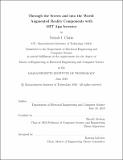| dc.contributor.advisor | Harold Abelson. | en_US |
| dc.contributor.author | Clarke, Nichole I. | en_US |
| dc.contributor.other | Massachusetts Institute of Technology. Department of Electrical Engineering and Computer Science. | en_US |
| dc.date.accessioned | 2019-11-22T00:02:27Z | |
| dc.date.available | 2019-11-22T00:02:27Z | |
| dc.date.copyright | 2019 | en_US |
| dc.date.issued | 2019 | en_US |
| dc.identifier.uri | https://hdl.handle.net/1721.1/123016 | |
| dc.description | This electronic version was submitted by the student author. The certified thesis is available in the Institute Archives and Special Collections. | en_US |
| dc.description | Thesis: M. Eng., Massachusetts Institute of Technology, Department of Electrical Engineering and Computer Science, 2019 | en_US |
| dc.description | Cataloged from student-submitted PDF version of thesis. | en_US |
| dc.description | Includes bibliographical references (pages 363-364). | en_US |
| dc.description.abstract | Augmented reality (AR) is an immersive technology which augments the real-world with virtual content. The added, virtual content is grounded in the real-world, provides in-context information, and creates experiences that could not be perceived by one's senses alone. As an educational technology, augmented reality has the power to motivate students and greatly shape their learning [1,2]. However, there's a lack of educational AR applications, and many educators and learners do not have the technical training to develop such applications. I hypothesize that one solution is to empower students by providing them with direct access to AR development tools and grounding their learning through computational action. My work focuses on creating such augmented reality development tools, which are comprehensible and employable by anyone. I built upon MIT App Inventor, a blocks-based mobile development tool, to democratize augmented reality application development. I developed a set of 20 augmented reality components, which allows users to build iOS augmented reality applications and enables the development of curriculum that promotes computational action with AR. I created a set of tutorials for the AR components and designed sample applications using those components with increasing levels of complexity. Finally, I conducted a pilot study with MIT students where they built applications using the augmented reality components. My findings indicate that study participants felt empowered by working with the AR components. Participants, who originally doubted their ability to create AR applications, believed that they could build augmented reality applications after using the AR components. | en_US |
| dc.description.statementofresponsibility | by Nichole I. Clarke. | en_US |
| dc.format.extent | 364 pages | en_US |
| dc.language.iso | eng | en_US |
| dc.publisher | Massachusetts Institute of Technology | en_US |
| dc.rights | MIT theses are protected by copyright. They may be viewed, downloaded, or printed from this source but further reproduction or distribution in any format is prohibited without written permission. | en_US |
| dc.rights.uri | http://dspace.mit.edu/handle/1721.1/7582 | en_US |
| dc.subject | Electrical Engineering and Computer Science. | en_US |
| dc.title | Through the screen and into the world : augmented reality components with MIT App Inventor | en_US |
| dc.title.alternative | Augmented reality components with MIT App Inventor | en_US |
| dc.type | Thesis | en_US |
| dc.description.degree | M. Eng. | en_US |
| dc.contributor.department | Massachusetts Institute of Technology. Department of Electrical Engineering and Computer Science | en_US |
| dc.identifier.oclc | 1127594088 | en_US |
| dc.description.collection | M.Eng. Massachusetts Institute of Technology, Department of Electrical Engineering and Computer Science | en_US |
| dspace.imported | 2019-11-22T00:02:26Z | en_US |
| mit.thesis.degree | Master | en_US |
| mit.thesis.department | EECS | en_US |
